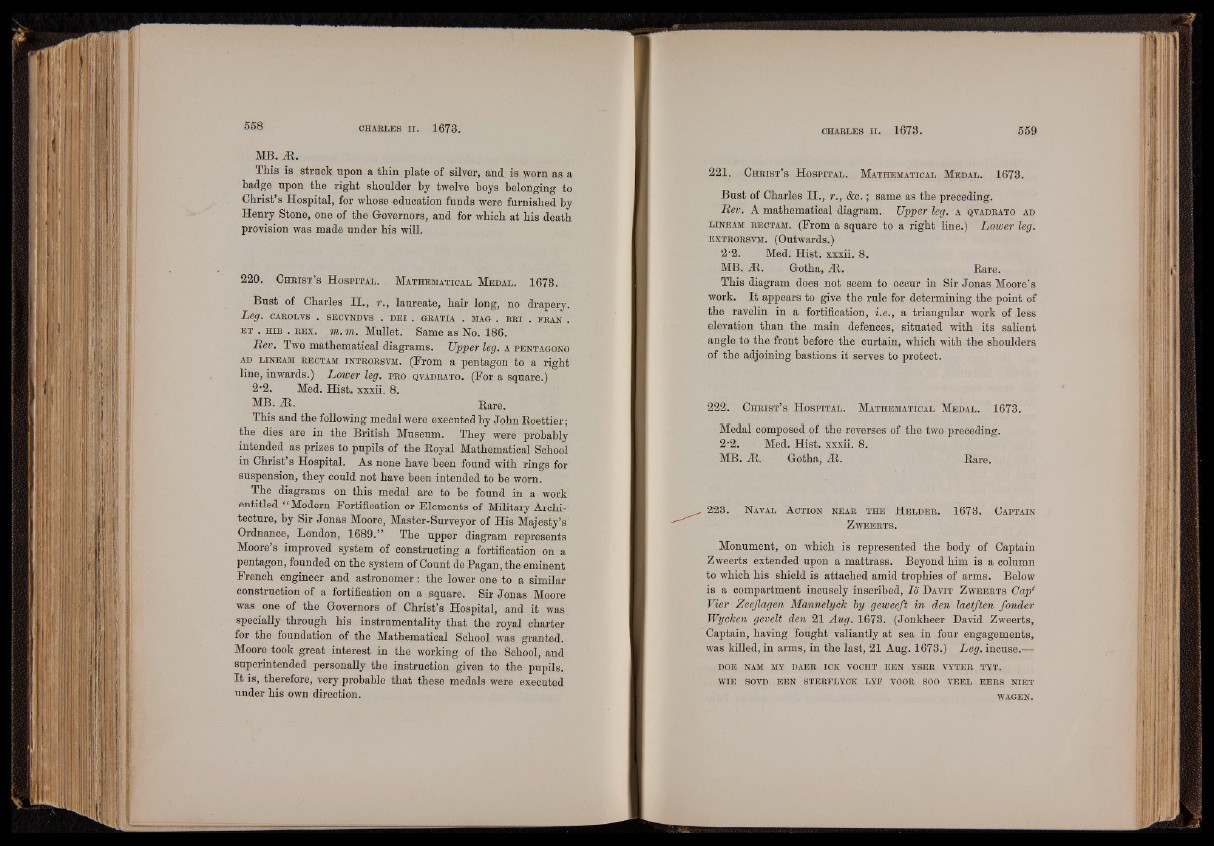
This is struck upon a thin plate of silver, and is worn as a
badge upon the right shoulder by twelve boys belonging to
Christ’s Hospital, for whose education funds were furnished by
Henry Stone, one of the Governors, and for which at his death
provision was made under his will.
2 2 0 . C h b i s t ’s H o s p it a l . M a th em a t ic a l M e d a l . 1673.
Bust of Charles II., r., laureate, hair long, no drapery.
Leg. CAEOLVS . SECVNDVS . DEI . GRATIA . MAG . BEI . FEAN .
ET . HIB . r e x . m. m. Mullet. Same as No. 186.
Rev. Two mathematical diagrams. Upper leg. a p e n ta g o n o
ad LINE AM EECTAM INTBORSVM. (From a pentagon to a right
line, inwards.) Lower leg. p b o qvadbato. (For a square.)
2‘2. Med. Hist, xxxii. 8.
MB. At. Bare.
This and the following medal were executed by John Boettier ;
the dies are in the British Museum. They were probably
intended as prizes to pupils of the Eoyal Mathematical School
in Christ s Hospital. As none have been found with rings for
suspension, they could not have been intended to be worn.
The diagrams on this medal are to be found in a work
entitled “ Modern Fortification or Elements of Military Architecture,
by Sir Jonas Moore, Master-Surveyor of His Majesty’s
Ordnance, London, 1689.” The upper diagram represents
Moore’s improved system of constructing a fortification on a
pentagon, founded on the system of Count de Pagan, the eminent
French engineer and astronomer : the lower one to a similar
construction of a fortification on a square. Sir Jonas Moore
was one of the Governors of Christ’s Hospital, and it was
specially through his instrumentality that the royal charter
for the foundation of the Mathematical School was granted.
Moore took great interest in the working of the School, and
superintended personally the instruction given to the pupils.
It is, therefore, very probable that these medals were executed
under his own direction.
221. C h r is t ’s H o s p it a l . M a th em a t ic a l M e d a l . 1673.
Bust of Charles II., r., &c.; same as the preceding.
Rev. A mathematical diagram. Upper leg. a qvadbato ad
l in e a m e e c t am . (From a square to a right line.) Lower leg.
ex t r o e sv m . (Outwards.)
2'2. Med. Hist, xxxii. 8.
MB. At. Gotha, At. Bare.
This diagram does not seem to occur in Sir Jonas Moore’s
work. I t appears to give the rule for determining the point of
the ravelin in a fortification, i.e., a triangular work of less
elevation than the main defences, situated with its salient
angle to the front before the curtain, which with the shoulders
of the adjoining bastions it serves to protect.
222. C h r i s t ’s H o s p it a l . M a th em a t ic a l M e d a l . 1673.
Medal composed of the reverses of the two preceding.
2-2. Med. Hist, xxxii. 8.
MB. At. Gotha, At. Bare.
223. N aval A c t io n n e a r t h e H e l d e e . 1673, Ca pta in
Z w e e e t s .
Monument, on which is represented the body of Captain
Zweerts extended upon a mattrass. Beyond him is a column
to which his shield is attached amid trophies of arms. Below
is a compartment incusely inscribed, Id D a v it Z w e e e t s Gap*
Vier Zeejlagen Mannelyck by geweeft in den laetften fonder
Wycken gevelt den 21 Aug. 1673. (Jonkheer David Zweerts,
Captain, having fought valiantly at sea in four engagements,
was killed, in arms, in the last, 21 Aug. 1673.) Leg. incuse.—
DOE NAM MY DAEE ICE VOCHT EEN YSEE VYTEE TYT.
WIE SOVD EEN STERFLYCK LYF VOOE SOO VEEL EERS NIET
WAGEN.